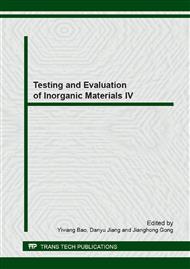p.117
p.122
p.126
p.130
p.134
p.138
p.145
p.150
p.154
Characterization of MCM-41 Mesoporous Silica Supported 2-Carboxyethyl Phenyl Phosphinic Acid
Abstract:
MCM-41 mesoporous silica was prepared by hydrothermal method. 2-carboxyethyl phenyl phosphinic acid (CEPPA) was loaded on MCM-41 by solution method. The structure of MCM-41 and its supported CEPPA was studied by X-ray diffraction (XRD), transmission electron microscope (TEM) and scanning electron microscopy (SEM) coupled with energy dispersive spectrometer (EDS). The results revealed that CEPPA was successfully loaded on MCM-41 with Si/P molar ratio of about 20:1. The XRD spectrum of MCM-41 supported CEPPA was different from MCM-41, indicating the structure of MCM-41 was changed after loading of CEPPA. CEPPA molecule moved into the mesoporous structure and filled in the mesopores, leading to the disappearance of characteristic diffraction peaks of MCM-41. The interaction between hydroxyl group of CEPPA and silanol of MCM-41 made it stable for CEPPA to be in the mesopores and on the surface of MCM-41. MCM-41 supported CEPPA also showed the similar mesoporous structure with long-range order to MCM-41 when observed by TEM. SEM provided further evidences of the similar particle size and different morphology.
Info:
Periodical:
Pages:
134-137
Citation:
Online since:
November 2013
Authors:
Price:
Сopyright:
© 2014 Trans Tech Publications Ltd. All Rights Reserved
Share:
Citation:


